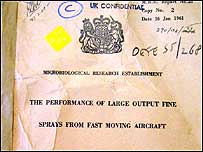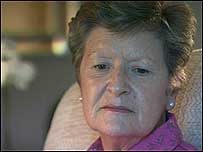
Clouds of secrecy
Nov 2006
http://www.bbc.co.uk/insideout/east/series10/week9_aerial_spraying.shtml
In the 1950s as the Cold War escalated, there were fears that Britain as an exposed, vulnerable island could be devastated by a biological or chemical warfare attack.
Ministry of Defence scientists from Porton Down in Wiltshire wanted to investigate how easily a huge cloud of deadly germs could spread across the country.
Between 1953 and 1964 top secret trials were carried out using a chemical concoction of zinc cadmium sulphide to simulate how a cloud would disperse biological agents.
The unsuspecting population was sprayed covertly with the poisonous compound at least 76 times.
Aerial spraying?
Aerial spraying took place a number of times over Norwich at night in 1963.
But it was not only Norfolk that was turned into an outdoor laboratory at this time.
Inside Out discloses the virtually unknown fact that large areas of Bedfordshire were sprayed out of the top of a converted lorry.
| Cadmium fact file |
| Cadmium is a minor element which occurs naturally. It is
one of the metallic components in the earth’s crust.
First discovered in Germany in 1817 as a by-product of zinc refining. Used for industrial purposes in batteries, pigments and plastics. Cadmium-sulfide pigments were used from 1850 in painting - the pigment is prominent in the work of Vincent Van Gogh. Thomas A. Edison in the USA and Waldemar Junger in Sweden developed the first nickel-cadmium batteries in the early 20th Century. Also used in nuclear fission. Cadmium is a poisonous heavy metal. If uncontrolled, it can produce toxic effects on humans. Ingestion of significant amounts of cadmium can lead to poisoning and damage to the liver, kidneys, and respiratory organs. |
Co-ordinated by Porton Down scientists at RAF Cardington, the surrounding villages and their inhabitants were subjected to chemical emissions at least 55 times over a six year period.
Specially modified weather balloons were used to collect the samples.
The Ministry of Defence has consistently said that there was no significant health hazard as a result of the experiments.
In Clouds of Secrecy, the Inside Out team investigates the facts and deceit about what happened, particularly in East Anglia, and concludes that much of the truth is at odds with the official line.
Cadmium is a poisonous heavy metal.
The zinc cadmium sulphide was not tested for toxicity prior to the experiments and this is now officially admitted to be a 'deficit'.
A report from Porton Down in 1967, four years after the trials stopped, states that short-term exposure to cadmium affects the respiratory system in humans.
High doses of cadmium over long periods of time cause bone and kidney
problems and lung cancer.
These admissions have never been acknowledged in recent enquiries.
Declassified information
Using information obtain under the Freedom of Information Act, we reveal from declassified files that cadmium was used because it was cheap.
But the secret files also admit that it was unreliable. Accounts of sampling were underestimated by a factor of 100 times due to environmental pollution and the inefficiency of the dispersal of zinc cadmium sulphide.
 |
| Casting new light - recently released files on spraying |
This toxic compound was considered safe to use because it fluoresces strongly when exposed to UV light and therefore be detected at sampling devices positioned around the country.
The Norwich experiments came to light in 2000 after an investigation into the activities of Porton Down.
This led to two reviews - one by DERA, the privatised evaluation arm of the MoD and another by an independent body comprising toxicologists and environmentalists led by a professor from Cambridge.
Both reports concluded, although not unreservedly, that there was no significant risk to human health.
Researcher Mike Kenner, who carried out the original FOI investigation, said:
"I find it incredibly difficult to understand that the so-called jewel in the crown of the British scientific community which is Porton Down would think that is was okay to spray a toxic material like cadmium sulphide over the population of Norfolk, Bedfordshire and Lincolnshire. It beggars belief."
Independent inquiry
Inside Out has discovered that the independent inquiry did not study the later Norwich trial reports when making their safety assessment.
More alarmingly they did not take into account any experiments done at Cardington in 1963 when there was a mass release of cadmium from a lorry.
| "I think if they were aware of the full spectrum of risks, it was probably questionable at very best." |
| Wyn Parry |
Some of the National Records were not available to Professor Lachmann from Cambridge at the time.
The story resurfaced last year after Wyn Parry, a thoracic surgeon at Norfolk and Norwich University Hospital, highlighted an upward trend in cases of throat cancer.
It was taken up by MPs Ian Gibson and Norman Lamb who demanded a public
inquiry.
Mr Parry said the industrial use of cadmium was now heavily regulated:
"It has been known for some years that cadmium is related to some disease."
Of the germ trials, he said:
"I think if they were aware of the full spectrum of risks, it was probably questionable at very best."
Family cases
Yvonne Jarman, from Norfolk, is one of the family cases which have been investigated.
Her mother, sister and brother have all died from throat cancer and she says she wants more answers.
"Even if they said it was good for the nation how good could it be for people to have this poisonous substance blown in the wind over them."
 |
| Looking for answers - Yvonne Jarman |
"If people knew what cadmium is there would certainly have been objections," she said.
A Department of Health-led investigation this year found that while cancer figures in Norwich are not higher than the national average, they are raised in Norfolk.
This prompted a small-cluster inquiry conducted by Imperial College which last month confirmed that the incidences of throat cancer were raised in Norfolk, but concluded that the levels were NOT significant.
Despite this finding, MP Ian Gibson said he'll continue his calls for more answers.
North East Bedfordshire MP Alistair Burt has also taken up the case as a result of the BBC documentary.
Professor Lachmann, who carried out the independent scientific study for the Ministry of Defence five years ago, said:
"We came to the conclusion that no-one is likely to have suffered any harm from the amounts of zinc cadmium sulphide they might have encountered in the worst scenario during that period."
Inside Out - East: Monday November 6, 2006http://www.bbc.co.uk/insideout/east/series10/week9_spraying_war_extra.shtml
Insider account - clouds of secrecy
Uncovering hidden secrets - Mike Kenner Between 1953 and 1964 top secret trials were carried out using a chemical concoction of zinc cadmium sulphide to simulate how a cloud would disperse biological agents.
The unsuspecting population in the East of England was sprayed covertly with the poisonous compound at least 76 times.
Mike Kenner is an "Open Government Campaigner" who stumbled across the Norwich and Bedford trials, and whose revelations prompted two Government Inquiries.
This article by Mike Kenner describes how he uncovered the story using files obtained under the Freedom of Information Act.
Investigating the trials
"During November 1998, the Sunday Telegraph published an exclusive article by Rob Evans and Andrew Gilligan."It revealed that scientists from the Chemical Defence Experimental Establishment (CDEE), Porton Down, had in the past, sprayed large parts of the UK with a toxic chemical compound - Zinc Cadmium sulphide (ZnCds).
"At the time of the article, I was already involved, as an Open Government campaigner, in calling for the Ministry of Defence to release more information concerning the 1963-1975 Porton Down public area Biological Warfare experiments, which had been conducted in my local area - South Dorset.
"After pressure from various MPs and concerned residents, the MOD eventually announced that they would commission yet another Independent Review, which would investigate possible adverse health effects caused by the public area ZnCds tests.
"This was the second Independent Review to be commissioned by the MOD during the late 1990s."The first review, conducted by Professor Brian Spratt FRS, investigated any possible adverse health effects experienced by the residents of southern England who were exposed to the massive aerosols of live bacteria, emitted during the Porton Down Dorset Defence Trials."
Opening up the files
"During the following years, I used Open Government legislation, such as the Code of Practice for Access to Government Information, in order to obtain more information about the ZnCds field trials.
"Initially, it was thought that 12 large-scale experiments had been conducted by CDEE scientists.
Casting new light - recently released files on spraying "My investigations soon revealed that this figure was a vast underestimation of the true figure.
"By the time that the Academy of Medical Sciences had been appointed to conduct their Independent Review (late 1999), the number of known experiments had risen to circa 70.
"Fortunately, examination of each newly declassified Porton scientific report revealed evidence of yet more ,as yet unknown, ZnCds field trials."Again, I would make a Code of Practice request to Porton Down and once again more information would be released.
"By now, the tally of known public area ZnCds experiments had risen to nearly 100."
Open air spraying
"During the course of my investigations I inadvertently stumbled across a cache of papers relating to trials which took place over Norfolk in 1963 and again in 1964."These trials turned out to be the last in this open-air spraying programme and were themselves unique because they involved the Home Office and the City of Norwich Police.
"On occasion, this newly declassified material has revealed information which contradicts that which is contained in the independent review.
Clouds of secrecy - Inside Out investigates "On at least two occasions, official Porton Down scientific reports have been discovered which were not even examined by the review.
"The first (Porton Technical Paper No 794) detailed a number of experiments where radioactive gas and ZnCds particles were released from AERE Harwell and were tracked for at least 60 kilometres downwind.
"The second (Porton Technical Paper No 885), detailed the numerous (circa 36) ZnCds field trials that were conducted by Porton Down scientists at Cardington, Bedfordshire, during 1963.
"Even more importantly, PTP No 885 revealed that the chemical compound used in the 1963 Cardington field trials (ZnCds) was sprayed by Porton scientists from a moving vehicle.
"This would have placed local Bedfordshire residents in much closer proximity to the source of sprayed ZnCds than previous trials, which had sprayed the ZnCds from an aircraft.
"Spraying this material from ground level could have led to a much higher received dosage of inhaled ZnCds amongst residents living close to the route of the Porton spray vehicle.
"The fact that such a large number of potentially hazardous field trials could be overlooked by a Government appointed Independent Review, and only be discovered by an ordinary resident using Open Government legislation, proves to me the true worth of the Freedom of Information Act."Mike Kenner
Notes
All views expressed in this article are those of the author, Mike Kenner.